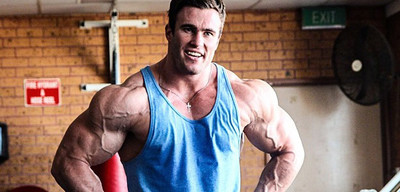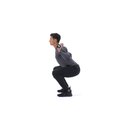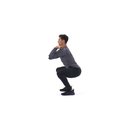If you were driving from San Diego to San Francisco, following a direct route straight up would get you there fastest, Southern California traffic notwithstanding. Sure, you could take alternate routes, checking out the gambling halls in Vegas, taking in the vistas of the Sierra Nevada mountain range and Yosemite, panning for gold in the foothills east of Sacramento, or even taking the meandering but scenic coastal route, but none of those routes are as direct, and they would add days to your travel.
Similarly, bodybuilders looking to add mass want a plan that leads to the fastest gains possible without extended delays. They don't do just any workout; they follow ones that intuitively make the most sense for building size. They don't avoid exercises that are hard; they select the best ones that can pack on mass. And they don't pick just any weight; they choose their load based on what optimally builds size.
Like the traveler, if you want to gain muscle, it makes sense to choose the most direct route possible when you're looking to gain muscle. There are certainly other less-direct paths you can take, but why be content with suboptimal results that require even more time to achieve?
Of course, getting there as fast as possible means giving nothing short of a hundred percent. You can follow the world's greatest workout program loaded with the best mass-building exercises, but if you approach it with half-assed effort, you'll get only half-assed results.
What are the key tips, techniques, exercises, and insiders' advice when it comes to leg training? We sought the expertise of Australian pro bodybuilder Calum von Moger, 24, winner of the 2014 Mr. Universe and Team Cellucor athlete.
Here are the most critical tips you should heed on leg day. Check out the list below carefully, and incorporate the advice into your routine.
1. Attack Legs As A Weak Point
"I'm a firm believer that squats are ultimately the best exercise for making gains, as they're a multijoint movement that utilizes all the musculature in the legs as well as the glutes," says Calum.
Many recreational lifters suffer from CLS—Chicken Leg Syndrome—due in no small part to years of prioritizing chest and arms over their thighs. You can't change what's already done but, going forward, prioritizing legs is key.
If you're afflicted with CLS, Calum recommends two important ways to help bring them up: "If legs are a weak point, I'd suggest training them twice a week, and making squats a priority in your workout," he says.
2. Start With Squats. Period.
Building on the last tip, you simply have to squat. You may think that any leg exercise will build your thighs if you work hard enough, but that's not the case.
As with any muscle group, choosing the most challenging movement and doing it first in your workout when your energy levels are high will pay the greatest dividends.
"I'm a firm believer that squats are ultimately the best exercise for making gains, as they're a multijoint movement that utilizes all the musculature in the legs as well as the glutes," says Calum. "I've always done them at the start of my workout, and I believe that's the only way you can put in 100-percent effort."
Squat variations—low-bar squats and front squats, in particular—are good alternatives that use slightly different muscle recruitment patterns and can be substituted on occasion for better overall strength and size development.
3. Go Deep
Besides never being seen in shorts, chicken-legged bodybuilders try to hide their lower-body weakness by loading up the squat bar—only to descend just a few inches. This attempt to hide their CLS fools no one, and the shortened range of motion also shortchanges their muscle gains.
"Full range of movement is best because it hits the whole muscle," says Calum. "If you're doing half reps, you're not working the muscle completely. That being said, an effective way to completely exhaust the muscle is by doing partial reps after you complete all your full-range reps at the end of the set."
Going deeper engages the glutes and hams to a greater degree than when you do shallow squats, whether you're actually doing squats, leg presses, hack squats, or other multijoint deep knee-bend movements. If you've got good flexibility, go to a point to where your hips are lower than your knee joint.
4. Change Up Your Foot Position
You can use any number of foot positions and widths with leg exercises like squats, leg presses, and hack squats, but for the most power, opt for a stance in which your feet are about shoulder-width apart and your toes are angled slightly outward. As your quest for size progresses, you'll want to add variety to your foot position.
"I'll frequently change leg position so that I can target every angle of my legs," says Calum. "I'll do narrow-stance squats to hit the outer sweep of the quads, followed by a wider stance to target the adductors (inner thighs). I apply the same principle to leg presses and leg extensions."
A word of caution: Don't angle your toes inward or excessively outward on closed-chain movements (where your feet are pressed flat against the ground or a machine), to ensure you don't cause damage to your knees.
5. Use High And Low Foot Placements
Many leg machines—including leg presses, hack squats, and horizontal leg sleds—have platforms that allow you to use any number of foot positions. It turns out that where you place your feet—high or low—makes a difference in terms of muscle recruitment.
Essentially, lower foot placements target the quads to a greater degree, while higher foot placements target the glutes and hamstrings more effectively. That doesn't mean you can isolate these muscles, but if you want to increase the muscular tension on a particular area, foot placement is one way to do so.
6. Implement The Most Underrated Exercise
Everyone knows squats are king, but what exercise is the most undervalued when it comes to leg day? According to Calum, it's weighted split squats. "This exercise is a killer for developing the teardrops in your quads, yet not many people do them," he says.
To do a split squat with dumbbells, start with one leg forward and the other back. Simply bend your knees and descend, then come back up again. Make sure your back knee doesn't touch the floor and, for joint health, make sure the knee of your forward leg doesn't extend past a vertical plane that comes directly up from your toes.
7. Focus On Your Quads
Leg day consists of a number of muscle groups—primarily quads, glutes, and hamstrings—but some exercises better target one region over another. Calum's picks for movements that do a better job on the quads include leg extensions, squats, single-leg presses, hack squats, sissy squats, and front squats.
He's also a big fan of using pre-exhaust with a single-joint exercise to start his leg workout, doing three working sets of leg extensions before he adds multijoint exercises.
8. Boost Your Training Intensity
The benefits of a good leg workout can be amplified when you add any number of intensity-boosting techniques to extend a given set and make your training harder. Besides pre-exhaust, in which you precede your heavy multijoint exercises with an isolation movement, Calum also favors these three intensity-boosting techniques:
- Dropsets, in which you quickly reduce the weight by about 25 percent once you reach muscle failure, and continue on with your set. Calum prefers to do these after his working sets.
- Partial reps, in which you do as many full-range reps as you can, then do a few more partials, either above or below your sticking point.
- Reduced rest time to increase training intensity.
9. Split Your Leg Workout
Leg day consists of exercises for several muscle groups, as discussed above, and many of the exercises are among the most demanding movements you'll do in any given week. Sometimes that makes training hamstrings an afterthought. Rather than trying to muster the energy to push through ham-specific movements, many bodybuilders simply opt to train their hammies on another day, often separated by at least 48 hours from their main quad session.
"I like to separate hamstrings from quads so that I can give each muscle group 100 percent," says Calum. "Train quads first one day, and follow up with maybe one exercise of hammies at the end; 2-3 days later, train hamstrings first and finish with calves."
10. Let Your Rep Range Drift Northward
Just about every exercise science text you'll read recommends choosing a weight you can do for just 8-12 reps for muscle growth (hypertrophy). But when it comes to leg day, Calum says that going with slightly higher reps works best: "I find [legs] respond best to higher reps because it takes a while for the blood to get pumped down there and fill up the muscle," he says.
Rather than reducing your working weight, strive to do more reps—up to 15—on your heaviest sets. This is an especially useful technique to try if your leg workout has gone stale and you're not seeing results.
11. Avoid Locking Out
When you're huffing and puffing toward the end of a fairly brutal set of squats or leg presses, it's tempting to momentarily take a break and lock out your knees. When you lock out a joint, some of the stress shifts from the working muscles to the joint, which puts ligaments and tendons under considerable strain. It also reduces the tension on the target muscle (translation: less growth stimulus), providing momentary relief from the pent-up fatigue while allowing for a short "break" during the set.
For joint safety, it's never a good idea to lock out a joint, especially when you're training with heavy weights. Take each rep through a full range of motion for maximal benefit, but stop just short of lockout.
12. Stop Going By The Rules
When you reach a training plateau, it can feel like nothing will help you over the hump. That's exactly when you need to start thinking outside the box. For Calum, that's when he starts breaking all the training rules he normally applies, following a principle called muscle confusion.
"I don't follow rules, I break them—that's my secret," he says. "Legs can be very stubborn; they expect you to follow the rules. So I like to surprise them by doing extra sets, reps, and different exercises than what I might have done the prior week. So long as you're struggling to walk properly afterward, you know you've done enough."
13. Hit Your Hammies From The Hip Joint
If your hamstring workout includes exercises like lying leg curls, standing leg curls, and seated leg curls, you're still only halfway home. All those exercises initiate movement from the knee joint. However, the hamstrings attach at both the knees and hips. You can focus on the upper ham region by including movements in which action takes place at the hips. The best way to do so is by including Romanian deadlifts (RDLs) in your hamstring routine.
Not to be confused with the stiff-legged deadlift, which is more of a lower-back exercise, the RDL effectively targets the glute/ham tie-in. While it takes some time to master this particular movement—push your butt back, make sure to keep your back flat throughout, keep your knees bent, and don't try to lower the weight all the way to the floor—it's a great way to complement leg curls for more complete hamstring development.
14. Include Two Types Of Calve Movements
Calves are usually done last on leg day, and most lifters throw on an exercise or two before calling it a day. But it would be a mistake to assume that all calf exercises are alike. While most calf movements are done with straight (but not locked-out) legs, bent-knee calf exercises are different in one important way: the soleus takes on the brunt of the workload.
This is because the gastrocnemius (one of two major lower-leg muscles) attaches above the knee joint, making it unable to contract very strongly when the knee is bent. With straight-legged movements, both muscles are called into play. Hence, doing a straight-legged calf exercise (such as standing or donkey calf raises), in addition to seated calf raises (done last), most effectively targets these lower-leg muscles.
15. Tune Your Mind In First
How do you mentally prepare for a killer leg workout like the kind Calum does to build his thighs? Try taking Calum's approach. "I normally start preparing the day before by eating up, so I'm full of carbs," he says. "Then I go over the workout in my head while driving to the gym, take my scoops of C4 pre-workout, and listen to the latest podcast of Hidden Forest."
Everyone has his or her personal preferences for getting amped for a good workout, but don't expect to just show up and enjoy an incredible workout. Prep your mind so that it's ready to take your muscles through a hardcore training session.
Here’s a sample leg-building plan based on the 15 laws!

BodyFit
$6.99/month- 2,500+ expert-created single workouts
- 3,500+ how-to exercise videos
- Detailed workout instruction
- Step-by-step workout tips
- Training at gym or at home
- Access to Workout Plans
- Access to Bodyfit App
- Store Discounts
Already have a Bodybuilding.com account with BodyFit? Sign In

What comes with BodyFit?

- Instructional Videos
Don't risk doing a workout improperly! Avoid injury and keep your form in check with in-depth instructional videos.

- How-to Images
View our enormous library of workout photos and see exactly how each exercise should be done before you give it a shot.

- Step-by-Step Instructions
Quickly read through our step-by-step directions to ensure you're doing each workout correctly the first time, every time.

BodyFit
$6.99/month- 2,500+ expert-created single workouts
- 3,500+ how-to exercise videos
- Detailed workout instruction
- Step-by-step workout tips
- Training at gym or at home
- Access to Workout Plans
- Access to Bodyfit App
- Store Discounts
Already have a Bodybuilding.com account with BodyFit? Sign In

What comes with BodyFit?

- Instructional Videos
Don't risk doing a workout improperly! Avoid injury and keep your form in check with in-depth instructional videos.

- How-to Images
View our enormous library of workout photos and see exactly how each exercise should be done before you give it a shot.

- Step-by-Step Instructions
Quickly read through our step-by-step directions to ensure you're doing each workout correctly the first time, every time.






